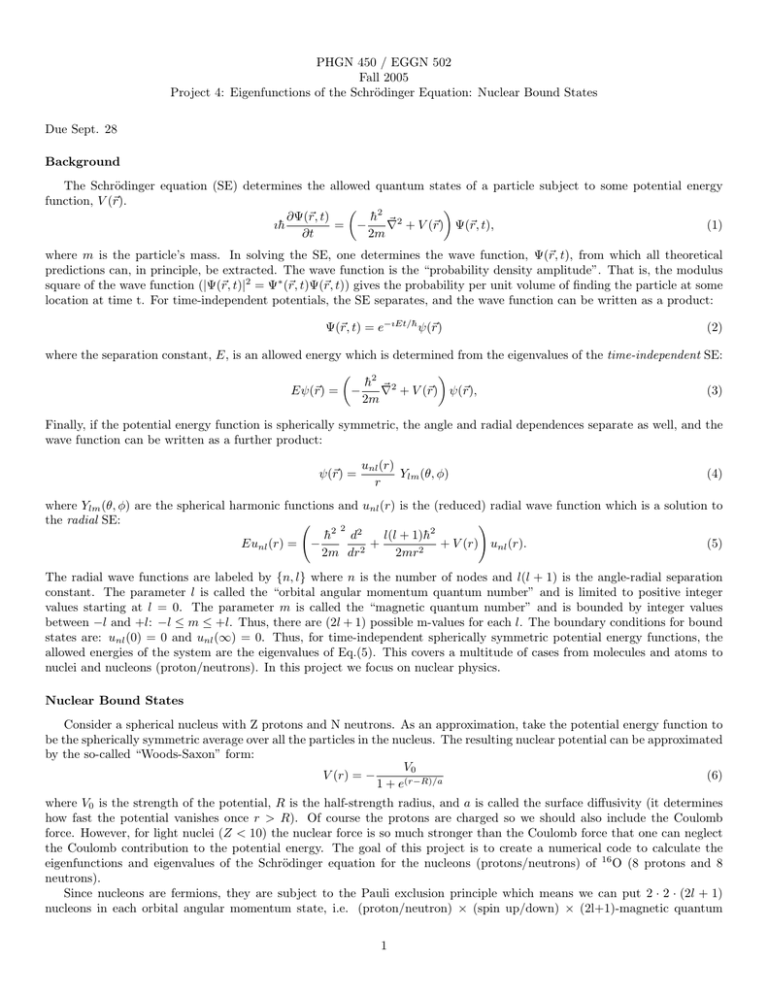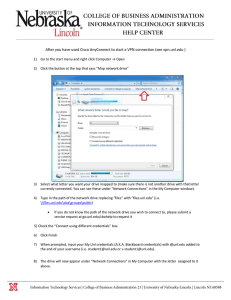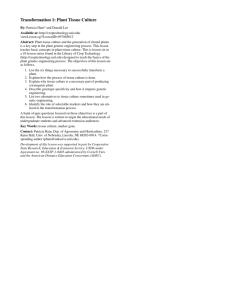PHGN 450 / EGGN 502 Fall 2005 odinger Equation: Nuclear Bound States
advertisement

PHGN 450 / EGGN 502
Fall 2005
Project 4: Eigenfunctions of the Schrödinger Equation: Nuclear Bound States
Due Sept. 28
Background
The Schrödinger equation (SE) determines the allowed quantum states of a particle subject to some potential energy
function, V (~r).
h̄2 ~ 2
∂Ψ(~r, t)
(1)
= −
∇ + V (~r) Ψ(~r, t),
ıh̄
∂t
2m
where m is the particle’s mass. In solving the SE, one determines the wave function, Ψ(~r, t), from which all theoretical
predictions can, in principle, be extracted. The wave function is the “probability density amplitude”. That is, the modulus
square of the wave function (|Ψ(~r, t)|2 = Ψ∗ (~r, t)Ψ(~r, t)) gives the probability per unit volume of finding the particle at some
location at time t. For time-independent potentials, the SE separates, and the wave function can be written as a product:
Ψ(~r, t) = e−ıEt/h̄ ψ(~r)
(2)
where the separation constant, E, is an allowed energy which is determined from the eigenvalues of the time-independent SE:
h̄2 ~ 2
Eψ(~r) = −
(3)
∇ + V (~r) ψ(~r),
2m
Finally, if the potential energy function is spherically symmetric, the angle and radial dependences separate as well, and the
wave function can be written as a further product:
ψ(~r) =
unl (r)
Ylm (θ, φ)
r
(4)
where Ylm (θ, φ) are the spherical harmonic functions and unl (r) is the (reduced) radial wave function which is a solution to
the radial SE:
!
2
h̄2 d2
l(l + 1)h̄2
Eunl (r) = −
+
+ V (r) unl (r).
(5)
2m dr2
2mr2
The radial wave functions are labeled by {n, l} where n is the number of nodes and l(l + 1) is the angle-radial separation
constant. The parameter l is called the “orbital angular momentum quantum number” and is limited to positive integer
values starting at l = 0. The parameter m is called the “magnetic quantum number” and is bounded by integer values
between −l and +l: −l ≤ m ≤ +l. Thus, there are (2l + 1) possible m-values for each l. The boundary conditions for bound
states are: unl (0) = 0 and unl (∞) = 0. Thus, for time-independent spherically symmetric potential energy functions, the
allowed energies of the system are the eigenvalues of Eq.(5). This covers a multitude of cases from molecules and atoms to
nuclei and nucleons (proton/neutrons). In this project we focus on nuclear physics.
Nuclear Bound States
Consider a spherical nucleus with Z protons and N neutrons. As an approximation, take the potential energy function to
be the spherically symmetric average over all the particles in the nucleus. The resulting nuclear potential can be approximated
by the so-called “Woods-Saxon” form:
V0
V (r) = −
(6)
1 + e(r−R)/a
where V0 is the strength of the potential, R is the half-strength radius, and a is called the surface diffusivity (it determines
how fast the potential vanishes once r > R). Of course the protons are charged so we should also include the Coulomb
force. However, for light nuclei (Z < 10) the nuclear force is so much stronger than the Coulomb force that one can neglect
the Coulomb contribution to the potential energy. The goal of this project is to create a numerical code to calculate the
eigenfunctions and eigenvalues of the Schrödinger equation for the nucleons (protons/neutrons) of 16 O (8 protons and 8
neutrons).
Since nucleons are fermions, they are subject to the Pauli exclusion principle which means we can put 2 · 2 · (2l + 1)
nucleons in each orbital angular momentum state, i.e. (proton/neutron) × (spin up/down) × (2l+1)-magnetic quantum
1
number states. For 16 O this means 4 nucleons can fit in the n = 0, l = 0 state and the remaining 12 nucleons go in the
n = 0, l = 1 state.
a. (10 points) Scale the radial SE using units appropriate to the Woods-Saxon potential. Use the potential strength, V0 to
scale the energies, and the half-strength radius, R, to scale the lengths. For example, let x = r/R, α = a/R, v(r) = V (r)/V0 ,
= E/V0 to find an equation of the form:
2
l(l + 1)
d
−
+ γ( − v(x)) unl (x) = 0
(7)
dx2
x2
and determine γ and v(x).
b. (10 points) The domain will be from 0 → xmax . By examining the rate the potential falls off, come up with some
criterion to estimate an xmax needed to determine the wave functions to, say, four digits (5 points). When you have finished
solving for the wave functions, review the sensitivity of your result to your estimate for xmax to confirm that you have indeed
satisfied the 4-digit accuracy goal (5 points).
Numerical Solution
The eigenvalue solution strategy will be similar to that used in the first project to find the bound state energies of the
hydrogen molecule. Here we seek the roots of Eq.(7) subject to the boundary conditions: {unl (0) = 0, unl (∞) = 0}. One
strategy to accomplish this objective is called the “shooting method”. First focus on one of the target l-values, l = 0 or 1.
Start with some guess for the bound state energy, say guess (note, bound state energies must be negative but above the
minimum in the potential energy). Use the Numerov method to integrate the differential equation backward (for stability)
from xmax to x = 0 and check to see if the wave function has the correct number of nodes and satisfies the boundary condition
at the origin. If not, adjust the energy guess, until the condition is satisfied to some arbitrary tolerance.
Recall that you need two points to start the Numerov integration. The first point, unl (xmax ), is arbitrary (any small
number will serve). The next point, unl (xmax − h), must be selected to satisfy the asymptotic limit (large x region) of the
radial SE. For sufficiently large values of x, the potential and angular momentum terms vanish and one has:
d2 unl (x)
(8)
= −γn unl (x), x >> 1.
dx2
√
The asymptotic solutions are e±κn x , where κn = −γn (Since is negative, κn is real.) Only the decreasing exponential
satisfies the boundary condition at infinity; therefore the appropriate guess for the second point needed to start your inward
integration is: unl (xmax − h) = unl (xmax )e+κh .
Since the first guess was arbitrary, the magnitude of your entire wave function will be scaled by it. The auxiliary
condition needed to fix the overall scale of the wave function is given by the physical condition that the probability of finding
the particle
anywhere is unity.
R∞
R ∞ Since the square of the wave function is the probability density, this implies the condition:
1 = 0 R(r) ∗ R(r) r2 dr = 0 u(x)2 dx. (Such wave functions are said to be “normalized”.) When you are done finding the
correct eigenvalue, normalize your wave function. (This can be done by using your favorite numerical integration routine to
calculate the normalization integral, and then dividing each value of the wave function by the square-root of that integral.)
c. (30 points) Write an algorithm to implement the shooting method for the scaled radial SE (20 points). Don’t try to
automate the energy guesses, just enter them by hand. Test it for the scaled spherical well potential given by:
−1 x ≤ 1
v(x) =
(9)
0
x>1
The (unnormalized) analytic solution for l = 0 is:
u(x) =
sin(kx)
sin(k)e−κ(x−1)
x≤1
x>1
(10)
where k 2 = γ(1 + ) and κ2 = −γ. For γ = 40, you should find ' −0.818 for the zero node solution and ' −.300 for the
one node solution. (10 points)
d. (40 points) Automate your energy search using the secant method (10 points). Next apply your algorithm to the
Woods-Saxon potential. (15 points) Use the following parameters: R = 3.0 fm, a = 0.67 fm, V0 = 50 MeV, mn = 939
MeV/c2 , h̄c = 197.33 MeV-fm. Find the (zero node) energy eigenvalues (in MeV) for the l = 0 and l = 1 orbitals. (10 points)
Normalize your wave functions and plot them. (5 points)
e. (10 points) Identify the arbitrary numerical parameters and test the stability of your results with respect to changes
in them.
2






